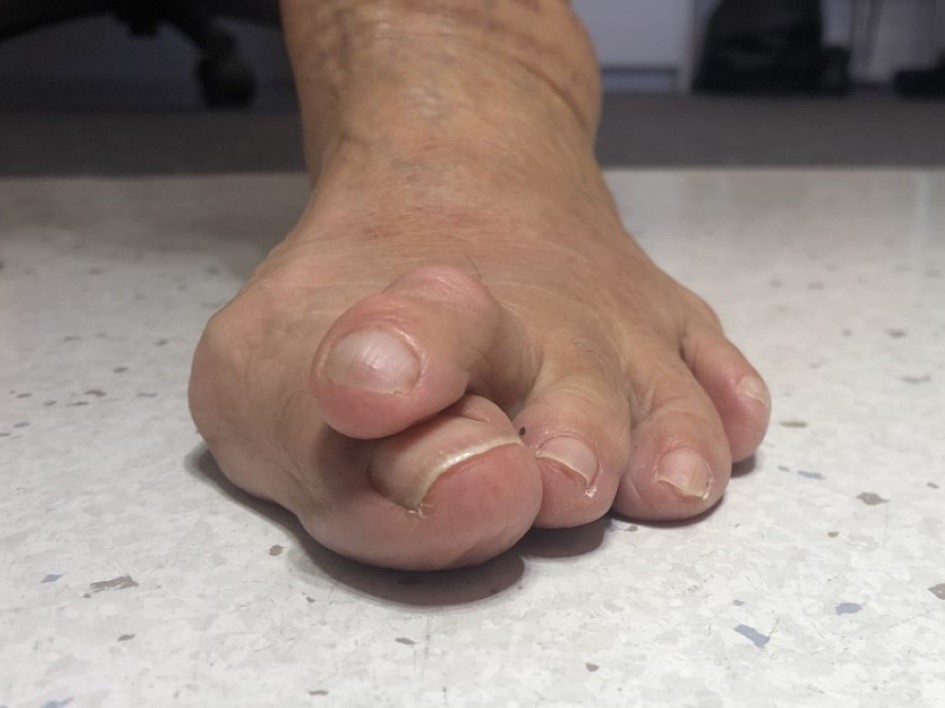What are hammer toes?
A hammer toe is a contracture or bent deformity of one or more joints of the toes. It can occur in all toes, but most commonly develops in the smaller toes.
The contracture of the toe can cause pressure when wearing footwear, leading to pain and preventing you from keeping active.
Hammer toes often start as a mild deformity and get progressively worse over time. Early on, the symptoms are mild and may be able to be managed conservatively.
However, if left to develop and untreated for an extended time, they can become more rigid and may require surgery to reduce pain and prevent further problems.
It is important to note that hammer toes will not get any better if left untreated. In early development, they are flexible and the symptoms can often be managed with conservative, non-surgical measures.
If left untreated, they will become more rigid and will no longer respond to non-invasive treatment.
Hammer toe causes
Muscular or tendon imbalance
The most common cause of a hammer toe is a muscle/tendon imbalance. The muscle/tendon imbalance is due to improper foot structure or function caused by flat or high arched feet or some neurological condition.
Over time the muscle/tendon imbalance leads to a bending of the toe.
Ill-fitting footwear
Hammer toes may also be aggravated by or caused by shoes that don’t fit properly. If a toe is long and forced into a cramped position, a hammertoe may result.
Genetics
In some people, hammer toes are inherited.
Trauma
Sometimes, a hammer toe may result from an injury to the affected toe.
Hammer toe Symptoms
Here are the symptoms to watch out for:
- Irritation or pain of the affected joint, especially when wearing shoes. Pain may also be due to arthritic change in more advanced cases.
- Redness, inflammation or burning
- Unsightly, contracted toe
- Corns or calluses on the top of the affected joint. This is usually due to constant friction from the shoe. The corns or callus may also form under the toe on the ball of the foot or even between two toes.
- In an advanced case, open wounds or ulcers may occur.
Options for Hammer toe treatment
Treatment will vary depending on your individual circumstances. Some types will prevent you from being active more than others.
A podiatrist or podiatric surgeon will advise you on your best treatment options. Hammer toes are treated with either conservative or surgical methods.
Conservative treatment of hammer toes
A variety of treatment options are available depending on the severity of the hammer toe and other factors.
Changes in footwear
Your podiatrist will educate you on appropriate footwear choices to help prevent further bending of your toes and keep you comfortable.
Treating and padding of corns and calluses
Regular debriding of corns or calluses will provide relief. Your podiatrist can advise or supply you with pads designed to shield corns from irritation and prevent skin breakdown.
Prescription orthotic devices
A prescription orthotic device can be used to correct the tendon/muscle imbalance and prevent further development.
Splinting/strapping
Splints or small straps may be used to straighten the toe and provide relief.
Medications
Non-steroidal anti-inflammatories such as ibuprofen may be taken to reduce pain and inflammation of the joint.
Injections
Inflammation of the tissues comprising a hammer toe can cause pain. Sometimes the inflammation is best treated using an injection or cortisone or steroid. A podiatrist or podiatric surgeon who has Scheduled Medicine Endorsement can administer a steroid injection to provide pain relief.
Hammer toe surgery
When a hammer toe has become painful and rigid, conservative treatment will not provide adequate relief. In these cases, surgery may be the best treatment option.
In many cases of painful hammer toes, a podiatric surgeon can perform minimally invasive (keyhole) surgery to straighten your toe. Minimally invasive surgery is the best surgical technique in most cases.
Sometimes, people with hammer toes will have other deformities such as a bunion and this may need to be corrected at the same time. The length of recovery depends on the necessary procedures.
How to prevent hammer toes

Hammer toes are progressive and will not go away by themselves. Early intervention and treatment by a podiatrist or podiatric surgeon is the best way to manage such a condition and keep you active.
There are, however, some measures you can take to prevent and/or slow the development. These measures should still be used to prevent further development, pain or disability caused by hammer toes.
Footwear choices
Avoid footwear that forces your toes against the front of the shoe. These include shoes with higher heels, pointed toe box or that are too short for your feet.
Choose shoes that are comfortable and have a deep toe box that allows movement. Heels should be no higher than 5cm.
Prescription orthotic devices
Prescription orthoses may prevent or slow the development of hammer toes. If you have orthoses, wear them for all physical activities such as walking and running.
Visit a podiatrist
Get advice from a podiatrist early. Not all cases are alike. Some cases develop more rapidly than others.
Once your podiatrist has evaluated your feet and circumstances they will advise whether you require treatment to assist in preventing the development of hammer toes.
Seek advice before using commercial splints and pads
It is important to never use a splint or device on your foot, such as a bunion splint until you have received advice from your podiatrist. You may cause more pain or deformity and waste money without the sound advice of your podiatrist.




